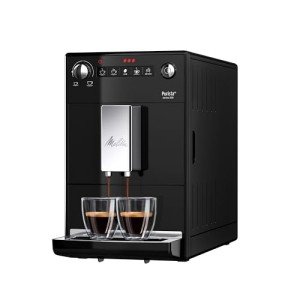15 Of The Best Pinterest Boards All Time About Italian Espresso Machines
Heat Exchange Espresso Machines: A Comprehensive Guide
Espresso machines have actually developed significantly over the years, catering to the needs of home baristas and coffee experts alike. Among these machines, heat exchange espresso machines have gotten popularity due to their ability to provide consistent performance and exceptional brew quality. In this post, we will check out the operations, advantages, and crucial features of heat exchange espresso machines, providing a thorough understanding for both potential buyers and coffee enthusiasts.
Understanding Heat Exchange Technology
Heat exchange espresso machines run on a special concept that enables synchronised water heating for developing and steaming. They are geared up with a single boiler that uses a heat exchanger system. This function is significant as it allows users to brew espresso while steaming milk simultaneously, promoting efficiency in the coffee-making procedure.
How Does a Heat Exchange Espresso Machine Work?
The procedure starts with the machine's water inlet filling the boiler. As the water warms up, it turns to steam. The innovative heat exchanger uses hot steam to heat additional water in a different passage developed particularly for the brew group. Compact Espresso Machines implies that water can reach the ideal brewing temperature without awaiting the boiler to change. The key actions include:
- Water Fill: Water is drawn into the boiler.
- Heating Process: The boiler warms up as water is transformed into steam.
- Heat Exchange: Steam warms water in the heat exchanger tube.
- Brewing: Water from the heat exchanger is pressed through coffee premises, drawing out the tastes required for a rich espresso.
This procedure permits fast temperature changes and enhanced coffee extraction.
Advantages of Heat Exchange Espresso Machines
Heat exchange espresso machines use numerous advantages, particularly for those looking to maximize their coffee experience. Here are some key advantages:
- Simultaneous Brewing and Steaming: Users can brew espresso while steaming milk, making it perfect for hectic coffee shops and home baristas who value effectiveness.
- Temperature Stability: The boiler's steam pressure helps preserve a steady temperature, which is crucial for constant espresso extraction.
- Adaptability: The style permits quick switching between developing and steaming, making it easier to create various coffee beverages, from lattes to coffees.
- Easy to use: Models frequently come with accessible controls, making it possible for both beginners and skilled baristas to produce quality beverages.
- Professional Quality: Heat exchange machines are typically used in commercial settings, supplying users with high-quality developing efficiency at home.
Key Features to Look for in Heat Exchange Espresso Machines
When thinking about the purchase of a heat exchange espresso machine, there are several functions that one should consider:
- Build Quality: Look for machines made of long lasting products, such as stainless steel or brass, making sure durability.
- Boiler Size: A larger boiler will hold more water and sustain greater output with time.
- PID Temperature Control: This function helps maintain constant brew temperature levels, which can enhance the coffee-making process.
- Group Head Design: Machines with a saturated or semi-saturated group head supply much better temperature stability.
- Alleviate of Use: User-friendly user interfaces and instinctive controls enhance the general experience for baristas at all skill levels.
- Steam Wand Quality: A good steam wand with correct insulation and flexibility permits better texturing of milk.
- Water Reservoir Size: Depending on your requirements, think about how frequently you desire to fill up the water reservoir.
Contrast of Popular Heat Exchange Espresso Machines
To better comprehend the options offered in the market, below is a comparison table of some popular heat exchange espresso machines:
Machine Model
Boiler Size
PID Control
Cost Range
User Ratings
Profitec Pro 700
2.0 L
Yes
₤ 2,000-₤ 2,500
9.5/ 10
Rocket Espresso R58
1.8 L
Yes
₤ 2,400-₤ 2,800
9.4/ 10
Elekta Bianca
1.8 L
Yes
₤ 2,500-₤ 3,000
9.6/ 10
La Spaziale S1 Vivaldi II
1.5 L
Yes
₤ 1,800-₤ 2,200
9.2/ 10
Bezzera Magica
1.2 L
No
₤ 1,600-₤ 1,800
9.0/ 10
Frequently Asked Questions About Heat Exchange Espresso Machines
What is the main difference in between a heat exchange and a dual boiler espresso machine?
While both types can brew espresso and steam milk at the same time, dual boiler machines have different boilers for brewing and steaming. On the other hand, heat exchange machines make use of a single boiler and a heat exchanger to achieve the same function.
Are heat exchange machines ideal for newbies?
Yes! Numerous heat exchange machines are developed with easy to use features, making them accessible for novices. With proper assistance and practice, users can rapidly produce quality espresso.
What type of maintenance do heat exchange espresso machines require?
Routine upkeep consists of descaling, cleaning up the boiler, inspecting seals and gaskets, and keeping the group head clean. Regular upkeep ensures durability and constant performance.
Can I use a heat exchange machine for different types of coffee drinks?
Definitely! Heat exchange machines permit users to produce a variety of coffee beverages, including espresso, lattes, coffees, and more.
Heat exchange espresso machines represent a blend of development and tradition, supplying coffee lovers with the tools required for crafting the perfect cup. Their ability to simultaneously brew and steam, combined with exact temperature level control, makes them an engaging option for both home baristas and professionals. With the right understanding on functions and upkeep, users can open a world of splendid coffee experiences, ensuring that each sip is as wonderful as the last.
